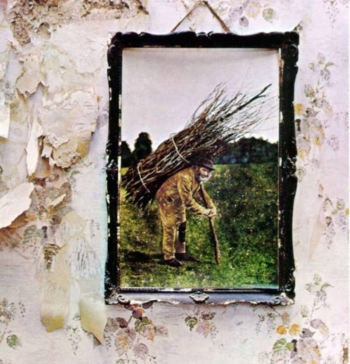 Led Zeppelin IV - (Four Symbols)
Led Zeppelin IV - (Four Symbols)
Led Zeppelin released their fourth album on 8th November 1971 with no title printed on the cover. Generally referred to as ‘Four Symbols’ or ‘Led Zeppelin IV’, it has since sold over 37 million copies worldwide, while critics have regularly placed it on lists of the greatest albums of all time.
Two months after the release of 'Led Zeppelin III' in October 1970 Jimmy Page and Robert Plant started work on its follow-up. For 'Led Zeppelin III' they had worked at Headley Grange in Hampshire, an 18th century former workhouse, popular for rehearsal with rock bands such as Fleetwood Mac, mainly because it was far enough from neighbours to avoid noise complaints. Led Zeppelin repeated the technique of recording there with the Rolling Stones mobile studio, continuing their working relationship with engineer Andy Johns. Ian 'Stu' Stewart, a founder member of the Rolling Stones, helped out, most notably on the piano for Rock And Roll. The Headley Grange sessions where they were able to capture spontaneous performances some arising from the communal jamming, yielded six out of the album's eight tracks.
Black Dog was named after a dog that hung around Headley Grange during recording. The a cappella section was influenced by Fleetwood Mac's Oh Well.
Bonham wrote the introduction to Rock and Roll from jamming around the intro to Little Richard's Keep A Knockin'.
Page wrote The Battle of Evermore on the mandolin. Plant added lyrics inspired by a book on the Scottish Independence Wars. The track features a duet between Plant and Fairport Convention's Sandy Denny; Plant plays the role of narrator while Denny sings the part of the town crier.
The classic Stairway To Heaven wasn't recorded at Headley Grange, although the lyrics were conceived there. Mostly written by Page, the lyrics were written by Plant about a woman who "took everything and gave nothing back". Jimmy Page had worked on the structure of the song with John Paul Jones, and based on that Robert Plant came up with most of the lyrics in a burst of inspiration on the spur of the moment around the fire at Headley Grange. The final take of the song was recorded at Island Studios after the Headley Grange session. The basic backing track featured Bonham on drums, Jones on electric piano and Page on acoustic guitar. Page played the guitar solo using a Fender Telecaster he had received from Jeff Beck. He put down three different takes of the solo and picked the best to put on the album.
Plant wrote Misty Mountain Hop about dealing with the clash against students and police around drug possession. The title comes from J. R. R. Tolkien's The Hobbit.
Four Sticks took its title from Bonham playing the drum pattern that runs throughout the song with four drum sticks. It was played live only once by Led Zeppelin and re-recorded with the Bombay Symphony Orchestra in 1972.
Going to California is a soft acoustic track written by Page and Plant about Californian earthquakes, and trying to find the perfect woman. The music was inspired by Joni Mitchell, both Plant and Page being her fans.
John Bonham's thunderous drum solo in When The Levee Breaks was captured with just two microphones in the hallway of the Headley Grange house. It comes from a blues song recorded by Memphis Minnie and Kansas Joe McCoy in 1929.
The album was not titled because the band deliberately wanted it so, going as far as identifying themselves with four symbols specilly chosen by each band member, the symbols themselves having no verbal or written equivalent.
No lettering was included anywhere on the original LP sleeve, not even the catalogue number. This was an intentional move on the part of Zeppelin to be judged solely on their music; and since the album continues to be hugely successful and influential, they probably were.
The rustic 19th century oil painting on the front cover was purchased by Robert Plant from an antique shop in Reading, Berkshire, then hung on the wall of a house in Eves Hill, Dudley, in the English Midlands, and photographed there. The original front cover showed only the painting of the old man with the bundle of sticks; only when the gatefold was opened out would the viewer see the more modern tower blocks beyond. The 20th century urban tower block on the back of the full gatefold LP cover is Butterfield Court in Eves Hill, Dudley, England.
The inside illustration entitled 'The Hermit', reminiscent of the Tarot card of the same name, is credited to Barrington Colby (more correctly, Coleby) MOM.
Jimmy Page arranged the printing of the lyrics to Stairway to Heaven on the inner bag in an alphabet he got created from a typeface he came across in the 19th Century art magazine 'Studio'.
In January 2010 the cover was among the ten chosen by Britain's Royal Mail for a set of 'Classic Album Cover' postage stamps.
Reviewed By Denzil Rego
Denzil is a diehard music aficionado who goes gaga over vinyl. His collection of LP records runs into thousands with EPs and SPs thrown in for good measure. You will find rarities and even autographed copies in his collection. He also has a fair amount of CDs and DVDs. A track and field star in his heyday, Denzil’s other passion is a holistic environment, #ARREGOGREEN –Making Our World A Better Place.
You can connect with Denzil via his Facebook page DenzMusicDen as well as his blog of the same name; else email him on denzilrego@yahoo.com or ping him on +91 7208082112.
